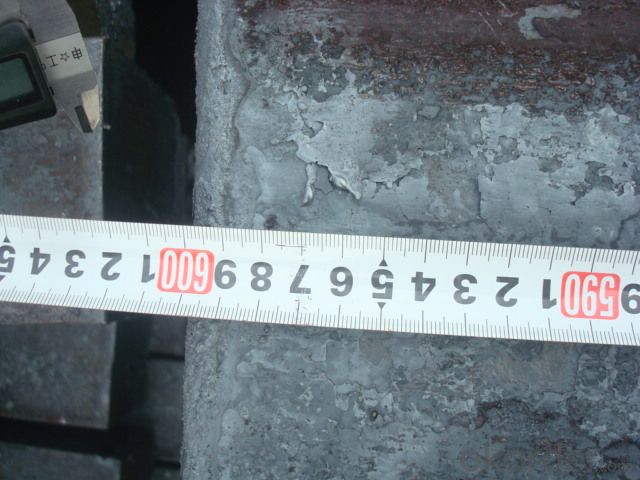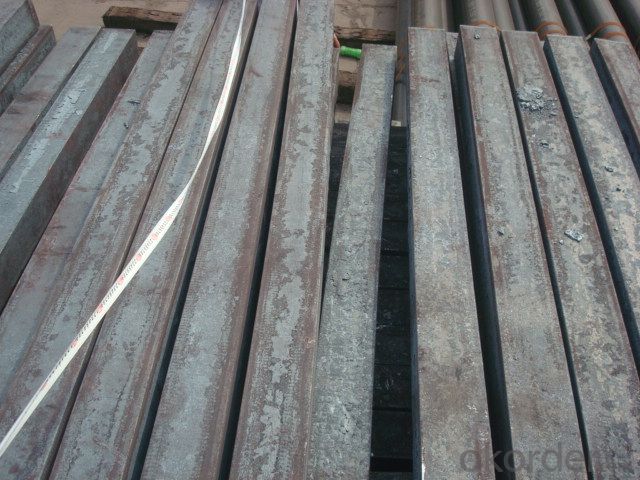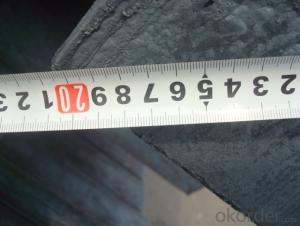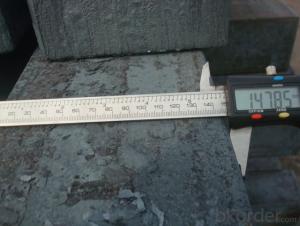Prime Steel Billet Q275, 20MnSi, 5SP,Q235
- Loading Port:
- Tianjin
- Payment Terms:
- TT OR LC
- Min Order Qty:
- 1000 m.t.
- Supply Capability:
- 20000 m.t./month
OKorder Service Pledge
OKorder Financial Service
You Might Also Like
STEEL BILLET
1.Brief description
Steel billet(ingot) by cogging or breakdown of semi-finished products, is the raw material of all kinds of steel mill. Billet section of square, round, flat, rectangular and abnormity of several kinds of, mainly related to the shape of rolled products.
2.Features
Rectangular billet continuous casting billet and mainly general carbon steel, low carbon low silicon cold-rolled material, high quality carbon structural steel, high strength low alloy steel, special steel, etc.
The billet is mainly divided into two kinds from the shape:
Slab: cross section width and height of the ratio of the larger, mainly used for rolling plate.
Billet: equal cross section width and height, or a huge difference, mainly used for rolling steel, wire rod. ,
Steel billets have distinct characteristics as compared with already furnished steel bars and products. Billets have a specific grain structure, which enables the metal to be processed more intricately. Steel billets are also known for their malleability and ductility, especially when exposed to varying temperatures during shaping and molding.
3.Processing
Steel billets are considered fresh and raw, and they must undergo a series of manufacturing processes before they can be used for various purposes. Billets are made by means of freezing molten liquid, and are later exposed to extremely low temperatures in order to allow the metal to take shape and solidify in chemical structure. The temperature manipulates the metal's physical properties, and tones its strength and durability. The subsequent processes provide the metal's curved mold design so that it can fit the allotted space provided by other machines, which complete the finishing procedures.
4.Pictures


5.Usage
Billets, or ingots (as they sometimes referred to), are not of practical use until they have been formed into more functional shapes and sizes. While they have already been put in the furnace, they still require a series of shaping and molding procedures such as hot and cold working, milling and cutting before they are sold in hardware stores, or used for different applications. The unformed billets, however, can be used in striking currency such as coins and as reserves, similar to gold bars.
6.Detailed specification
Hot rolled billet steel
Size: 50x50mm-180x180mm
Steel Grade: 3SP, 5SP,Q195,Q235,Q255,Q275 Length:3m-12m
MOQ: 1000MT/size
Payment term: TT or LC
Packing: in bulk , bundle
Shipment: by container , bulk vessel
Packaging Details: bundles with steel strips or as customers's requirements
Delivery time: 15-30 days after the deposit
Loading port:Tianjin, or other port China
Origin : China
Inspection:Third party inspection before loading.
- Q:What is the role of steel billets in the production of wire rods?
- Wire rods depend greatly on steel billets for their production. These long, cylindrical metal rods are widely utilized in construction, automotive, and manufacturing industries. To begin the production process of wire rods, steel is melted in either an electric arc furnace or a basic oxygen furnace. Once the desired temperature and composition are achieved, the molten steel is poured into molds, resulting in the formation of steel billets. Steel billets act as semi-finished products that serve as the initial stage in the wire rod manufacturing process. These solid bars of steel, which can be rectangular or round, undergo further processing to be transformed into wire rods. The conversion of steel billets into wire rods commences with a reheating process. The billets are subjected to high temperatures, making them more malleable and easier to manipulate. This reheating process is typically carried out in a reheat furnace. Following reheating, the billets are passed through a series of rolling mills. This reduces their size and shapes them into wire rods. These rolling mills apply a combination of pressure and heat to deform the steel billets, elongating them into long, thin rods. This rolling process also enhances the mechanical properties of the wire rods, such as their strength and flexibility. Once the wire rods are formed, they may undergo additional treatments, including cooling, surface treatments, and quality inspections. These treatments are necessary to meet the specific requirements of different applications. The wire rods can then be further processed into various products, such as wires, cables, reinforcement bars, or other specialized components. In conclusion, steel billets are a critical component in the production of wire rods. They serve as the starting material, undergoing various processing steps, such as reheating and rolling, to achieve the desired shape and properties of wire rods.
- Q:What are the common quality control measures for steel billets?
- Steel billets undergo several quality control measures to ensure their compliance with standards and specifications. These measures include: 1. Dimensional checks: The length, width, and thickness of the billets are measured to ensure they fall within the specified tolerances. Any deviations from the required dimensions may indicate potential quality issues. 2. Visual inspection: Visual aids like magnifying glasses or cameras are used to visually inspect the billets for surface defects such as cracks, scratches, or dents. This inspection ensures that the surface is free from imperfections. 3. Analysis of chemical composition: A sample is taken from the billet and analyzed to determine its chemical composition. This analysis ensures that the steel meets the specified requirements in terms of the percentage of different elements. Deviations from the desired composition can affect the steel's strength and other properties. 4. Mechanical testing: Various mechanical tests, including tensile testing, hardness testing, impact testing, and bend testing, are conducted on the billets to assess their strength, ductility, and other mechanical properties. The results are compared to the specified standards to ensure compliance. 5. Ultrasonic testing: This non-destructive testing method is employed to detect internal defects or irregularities within the billets. By sending ultrasonic waves through the billet, any reflected waves or changes in wave patterns can indicate the presence of defects like voids, inclusions, or cracks. 6. Verification of heat treatment: Heat treatment processes are often applied to steel billets to enhance their properties. Quality control measures involve verifying the proper execution of these treatments through tests like hardness testing or microstructure analysis. 7. Inspection of surface finish: The surface finish of the billets is checked to ensure it meets the specified requirements. This inspection involves measuring surface roughness or visually inspecting for any deviations from the desired finish, such as scale, rust, or uneven surfaces. By implementing these quality control measures, steel manufacturers can guarantee that the billets they produce meet the required standards and specifications, resulting in high-quality end products.
- Q:How are steel billets used in the manufacturing of railway tracks?
- Steel billets are used in the manufacturing of railway tracks by being heated and shaped into long, thick bars. These bars are then further processed, including cutting, drilling, and shaping, to form the individual sections of the track. The high strength and durability of steel billets make them suitable for withstanding the heavy loads and constant wear and tear experienced by railway tracks.
- Q:How are steel billets used in the production of automotive frames?
- Steel billets serve as the primary raw material in the production of automotive frames. These billets, which are essentially long, rectangular-shaped pieces of steel, undergo heating and subsequent shaping using diverse manufacturing processes. Specifically, in the case of automotive frames, billets are heated and then passed through a series of dies and rollers to attain the desired shape and dimensions. Once the billets have taken on the appropriate form, they undergo further processing through cutting, bending, and welding techniques. These techniques are employed to create the intricate and robust structure characteristic of automotive frames. The preference for steel billets in automotive frame production stems from the material's exceptional strength and durability, critical factors in ensuring vehicle safety and structural integrity. Furthermore, steel billets offer exceptional formability and machinability. This enables manufacturers to craft complex frame designs that meet the specific requirements of different vehicle models. Additionally, steel is a cost-effective material, making it a favored choice for mass production within the automotive industry. In conclusion, steel billets play a crucial role in the production of automotive frames. They provide a robust and dependable foundation for the vehicle's structure. Combined with advanced manufacturing techniques, the utilization of these raw materials ensures that automotive frames can withstand a variety of forces and impacts, ultimately enhancing the overall safety and performance of vehicles.
- Q:How do steel billets contribute to the telecommunications industry?
- Steel billets are used in the telecommunications industry to manufacture various infrastructure components such as towers, poles, and cables. These components provide the necessary support and stability for the installation of telecommunication equipment, ensuring reliable and efficient communication networks. Steel billets contribute to the industry by providing the raw material needed for the production of these essential infrastructure components.
- Q:Can steel billets be used in the production of marine equipment?
- Marine equipment can indeed utilize steel billets. Steel possesses remarkable characteristics such as strength, durability, and resistance to corrosion, rendering it a fitting choice for marine purposes. In the process of manufacturing steel, semi-finished products called steel billets can be further processed and transformed into diverse components for marine equipment, including ship hulls, propeller shafts, rudders, and offshore structures. The remarkable strength-to-weight ratio of steel makes it an ideal material to withstand the rigorous conditions encountered in marine environments, encompassing exposure to saltwater, extreme temperatures, and mechanical stresses. Moreover, steel allows for easy fabrication, welding, and machining, enabling the customization and production of intricate designs for marine equipment. Ultimately, steel billets represent a valuable raw material in the production of marine equipment due to their strength, durability, and suitability for marine applications.
- Q:What are the different types of cutting techniques used for steel billets?
- Different cutting techniques are employed for steel billets, depending on the specific requirements of the project. Several commonly used techniques include: 1. Sawing: This traditional and widely utilized method involves cutting through the steel billet using a saw blade. It can be done manually or with automated sawing machines, making it suitable for both small and large billets. 2. Flame Cutting: Also known as oxy-fuel cutting, this technique employs a flame torch to heat the steel to its kindling temperature. Then, a jet of oxygen is introduced to burn through the metal. It is frequently used for cutting thicker billets and can be performed manually or with CNC-controlled equipment. 3. Plasma Cutting: By utilizing a high-velocity jet of ionized gas, plasma cutting melts and blows away the steel. This technique is particularly effective for cutting billets with complex shapes or contours. It is often automated and produces clean and precise cuts. 4. Waterjet Cutting: This technique involves the use of a high-pressure jet of water combined with abrasive particles to cut through the steel billet. It is ideal for materials sensitive to heat, as it minimizes heat-affected zones. Waterjet cutting is capable of handling various thicknesses and shapes of billets. 5. Laser Cutting: Laser cutting employs a high-powered laser beam to melt and vaporize the steel, resulting in a clean and precise cut. It is highly accurate and suitable for cutting intricate shapes and designs. Laser cutting is commonly automated and widely used in industrial settings. Factors such as desired precision, speed, material thickness, and budget must be considered when selecting the most appropriate cutting technique for steel billets. Each technique has its own advantages and limitations, and choosing the right one can significantly impact the quality and efficiency of the cutting process.
- Q:How are steel billets used in the production of pipes?
- Steel billets are melted and then cast into a solid form, which is then rolled or forged to form pipes of various sizes and shapes. These billets serve as the raw material for the pipe production process and are essential in ensuring the strength, durability, and structural integrity of the pipes.
- Q:What are the common testing methods used for quality control of steel billets?
- The common testing methods used for quality control of steel billets include visual inspection, dimensional measurements, chemical analysis, and mechanical testing. Visual inspection involves examining the surface of the billets for any defects or abnormalities. Dimensional measurements ensure that the billets meet the specified size and shape requirements. Chemical analysis determines the composition of the steel, checking for the presence of impurities or elements that may affect the quality. Mechanical testing involves subjecting the billets to various tests such as hardness testing, tensile testing, and impact testing to evaluate their strength and other mechanical properties. These testing methods ensure that the steel billets meet the required quality standards.
- Q:How are steel billets used in the manufacturing of bridges?
- Steel billets are used in the manufacturing of bridges as raw materials that are further processed and shaped into various structural components, such as beams, columns, and girders. These billets undergo hot rolling, forging, or extrusion processes to form the required shapes and sizes for the bridge's structural elements. The high strength and durability of steel make it an ideal material for constructing bridges, and the use of steel billets ensures the production of strong, reliable, and long-lasting bridge structures.
1. Manufacturer Overview |
|
|---|---|
| Location | |
| Year Established | |
| Annual Output Value | |
| Main Markets | |
| Company Certifications | |
2. Manufacturer Certificates |
|
|---|---|
| a) Certification Name | |
| Range | |
| Reference | |
| Validity Period | |
3. Manufacturer Capability |
|
|---|---|
| a)Trade Capacity | |
| Nearest Port | |
| Export Percentage | |
| No.of Employees in Trade Department | |
| Language Spoken: | |
| b)Factory Information | |
| Factory Size: | |
| No. of Production Lines | |
| Contract Manufacturing | |
| Product Price Range | |
Send your message to us
Prime Steel Billet Q275, 20MnSi, 5SP,Q235
- Loading Port:
- Tianjin
- Payment Terms:
- TT OR LC
- Min Order Qty:
- 1000 m.t.
- Supply Capability:
- 20000 m.t./month
OKorder Service Pledge
OKorder Financial Service
Similar products
New products
Hot products
Related keywords






























